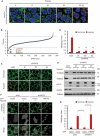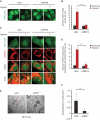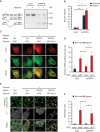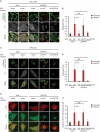Autosomal dominant retinitis pigmentosa-associated gene PRPF8 is essential for hypoxia-induced mitophagy through regulating ULK1 mRNA splicing
- PMID: 30103670
- PMCID: PMC6135625
- DOI: 10.1080/15548627.2018.1501251
Autosomal dominant retinitis pigmentosa-associated gene PRPF8 is essential for hypoxia-induced mitophagy through regulating ULK1 mRNA splicing
Abstract
Aged and damaged mitochondria can be selectively degraded by specific autophagic elimination, termed mitophagy. Defects in mitophagy have been increasingly linked to several diseases including neurodegenerative diseases, metabolic diseases and other aging-related diseases. However, the molecular mechanisms of mitophagy are not fully understood. Here, we identify PRPF8 (pre-mRNA processing factor 8), a core component of the spliceosome, as an essential mediator in hypoxia-induced mitophagy from an RNAi screen based on a fluorescent mitophagy reporter, mt-Keima. Knockdown of PRPF8 significantly impairs mitophagosome formation and subsequent mitochondrial clearance through the aberrant mRNA splicing of ULK1, which mediates macroautophagy/autophagy initiation. Importantly, autosomal dominant retinitis pigmentosa (adRP)-associated PRPF8 mutant R2310K is defective in regulating mitophagy. Moreover, knockdown of other adRP-associated splicing factors, including PRPF6, PRPF31 and SNRNP200, also lead to ULK1 mRNA mis-splicing and mitophagy defects. Thus, these findings demonstrate that PRPF8 is essential for mitophagy and suggest that dysregulation of spliceosome-mediated mitophagy may contribute to pathogenesis of retinitis pigmentosa.
Keywords: Autosomal dominant retinitis pigmentosa; PRPF8; ULK1; hypoxia; mRNA splicing; mitophagy.
Figures






Similar articles
-
Mutations in the pre-mRNA splicing-factor genes PRPF3, PRPF8, and PRPF31 in Spanish families with autosomal dominant retinitis pigmentosa.Invest Ophthalmol Vis Sci. 2003 May;44(5):2171-7. doi: 10.1167/iovs.02-0871. Invest Ophthalmol Vis Sci. 2003. PMID: 12714658
-
Mutation Analysis of Pre-mRNA Splicing Genes PRPF31, PRPF8, and SNRNP200 in Chinese Families with Autosomal Dominant Retinitis Pigmentosa.Curr Mol Med. 2018;18(5):287-294. doi: 10.2174/1566524018666181024160452. Curr Mol Med. 2018. PMID: 30360737 Clinical Trial.
-
Retinitis pigmentosa-linked mutations impair the snRNA unwinding activity of SNRNP200 and reduce pre-mRNA binding of PRPF8.Cell Mol Life Sci. 2025 Mar 5;82(1):103. doi: 10.1007/s00018-025-05621-z. Cell Mol Life Sci. 2025. PMID: 40045025 Free PMC article.
-
Mutations in spliceosomal proteins and retina degeneration.RNA Biol. 2017 May 4;14(5):544-552. doi: 10.1080/15476286.2016.1191735. Epub 2016 Jun 14. RNA Biol. 2017. PMID: 27302685 Free PMC article. Review.
-
Autosomal dominant retinitis pigmentosa secondary to pre-mRNA splicing-factor gene PRPF31 (RP11): review of disease mechanism and report of a family with a novel 3-base pair insertion.Ophthalmic Genet. 2013 Dec;34(4):183-8. doi: 10.3109/13816810.2012.762932. Epub 2013 Jan 23. Ophthalmic Genet. 2013. PMID: 23343310 Review.
Cited by
-
Advances in epigenetic modifications of autophagic process in pulmonary hypertension.Front Immunol. 2023 Jun 16;14:1206406. doi: 10.3389/fimmu.2023.1206406. eCollection 2023. Front Immunol. 2023. PMID: 37398657 Free PMC article. Review.
-
Assessment of mitophagy in mt-Keima Drosophila revealed an essential role of the PINK1-Parkin pathway in mitophagy induction in vivo.FASEB J. 2019 Sep;33(9):9742-9751. doi: 10.1096/fj.201900073R. Epub 2019 May 23. FASEB J. 2019. PMID: 31120803 Free PMC article.
-
RNA-binding proteins in human genetic disease.Nat Rev Genet. 2021 Mar;22(3):185-198. doi: 10.1038/s41576-020-00302-y. Epub 2020 Nov 24. Nat Rev Genet. 2021. PMID: 33235359 Review.
-
BNIP3 phosphorylation by JNK1/2 promotes mitophagy via enhancing its stability under hypoxia.Cell Death Dis. 2022 Nov 17;13(11):966. doi: 10.1038/s41419-022-05418-z. Cell Death Dis. 2022. PMID: 36396625 Free PMC article.
-
eIF4A3 regulates the TFEB-mediated transcriptional response via GSK3B to control autophagy.Cell Death Differ. 2021 Dec;28(12):3344-3356. doi: 10.1038/s41418-021-00822-y. Epub 2021 Jun 22. Cell Death Differ. 2021. PMID: 34158631 Free PMC article.
References
-
- Kitada T, Asakawa S, Hattori N, et al. Mutations in the parkin gene cause autosomal recessive juvenile parkinsonism. Nature. 1998. April 9;392(6676):605–608. PubMed PMID: 9560156. - PubMed
-
- Valente EM, Abou-Sleiman PM, Caputo V, et al. Hereditary early-onset Parkinson’s disease caused by mutations in PINK1. Science. 2004. May 21;304(5674):1158–1160. PubMed PMID: 15087508. - PubMed
Publication types
MeSH terms
Substances
LinkOut - more resources
Full Text Sources
Other Literature Sources
Molecular Biology Databases
Research Materials
